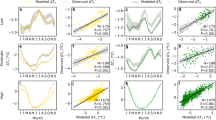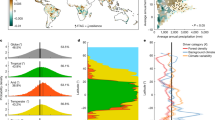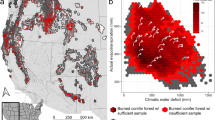Abstract
Climate change and disturbance threaten forested ecosystems across the globe. Our ability to predict the future distribution of forests requires understanding the limiting factors for regeneration. Forest canopies buffer against near-surface air temperature and vapour pressure deficit extremes, and ongoing losses of forest canopy from disturbances such as wildfire can exacerbate climate constraints on natural regeneration. Here we combine experimental, empirical and simulation-based evidence to show that soil surface temperatures constrain the low-elevation extent of forests in the western United States. Simulated potential soil surface temperatures predict the position of the low-elevation forest treeline, exhibiting temperature thresholds consistent with field and laboratory studies. High-resolution historical and future surface temperature maps show that 107,000–238,000 km2 (13–20%) of currently forested area exceeds the critical thermal threshold for forest regeneration and this area is projected to more than double by 2050. Soil surface temperature is an important physical control on seedling survival at low elevations that will likely be an increasing constraint on the extent of western United States forests as the climate warms.
This is a preview of subscription content, access via your institution
Access options
Access Nature and 54 other Nature Portfolio journals
Get Nature+, our best-value online-access subscription
$32.99 / 30 days
cancel any time
Subscribe to this journal
Receive 12 print issues and online access
$259.00 per year
only $21.58 per issue
Buy this article
- Purchase on SpringerLink
- Instant access to full article PDF
Prices may be subject to local taxes which are calculated during checkout



Similar content being viewed by others
Data availability
All data that support the findings of this study are openly available at the references provided. New and derived datasets, including seedling experiments and 30 m gridded surface temperature predictions, are available via Figshare at https://doi.org/10.6084/m9.figshare.26950843 (ref. 51).
Code availability
The data and code that support the findings of this study are available via Figshare at https://doi.org/10.6084/m9.figshare.26950843 (ref. 51).
References
Bonan, G. B. Forests and climate change: forcings, feedbacks, and the climate benefits of forests. Science 320, 1444–1449 (2008).
Pan, Y. et al. A large and persistent carbon sink in the world’s forests. Science 333, 988–993 (2011).
Anderegg, W. R. L. et al. A climate risk analysis of Earth’s forests in the 21st century. Science 377, 1099–1103 (2022).
Allen, C. D. et al. A global overview of drought and heat-induced tree mortality reveals emerging climate change risks for forests. For. Ecol. Manag. 259, 660–684 (2010).
IPCC Climate Change 2021: The Physical Science Basis (Cambridge Univ. Press, 2021).
Abatzoglou, J. T. & Williams, A. P. Impact of anthropogenic climate change on wildfire across western US forests. Proc. Natl Acad. Sci. USA 113, 11770–11775 (2016).
Anderegg, W. R. L. et al. Tree mortality from drought, insects, and their interactions in a changing climate. New Phytol. 208, 674–683 (2015).
Stevens-Rumann, C. S. et al. Evidence for declining forest resilience to wildfires under climate change. Ecol. Lett. 21, 243–252 (2018).
Davis, K. T. et al. Reduced fire severity offers near-term buffer to climate-driven declines in conifer resilience across the western United States. Proc. Natl Acad. Sci. USA 120, e2208120120 (2023).
Coop, J. D. et al. Wildfire-driven forest conversion in western North American landscapes. BioScience 70, 659–673 (2020).
Körner, C. & Paulsen, J. A world-wide study of high altitude treeline temperatures. J. Biogeogr. 31, 713–732 (2004).
Harsch, M. A., Hulme, P. E., McGlone, M. S. & Duncan, R. P. Are treelines advancing? A global meta-analysis of treeline response to climate warming. Ecol. Lett. 12, 1040–1049 (2009).
Elsen, P. R. & Tingley, M. W. Global mountain topography and the fate of montane species under climate change. Nat. Clim. Change 5, 772–776 (2015).
Jackson, S. T., Betancourt, J. L., Booth, R. K. & Gray, S. T. Ecology and the ratchet of events: climate variability, niche dimensions, and species distributions. Proc. Natl Acad. Sci. USA 106, 19685–19692 (2009).
Pulliam, H. R. On the relationship between niche and distribution. Ecol. Lett. 3, 349–361 (2000).
Tyree, M. T. Plant hydraulics: the ascent of water. Nature 423, 923–923 (2003).
Kolb, P. F. & Robberecht, R. High temperature and drought stress effects on survival of Pinus ponderosa seedlings. Tree Physiol. 16, 665–672 (1996).
League, K. & Veblen, T. Climatic variability and episodic Pinus pondoras establishment along the forest-grassland ecotones of Colorado. For. Ecol. Manag. 228, 98–107 (2013).
Rother, M. & Veblen, T. Climate drives episodic conifer establishment after fire in dry ponderosa pine forests of the Colorado Front Range, USA. Forests 8, 159 (2017).
Davis, K. T., Dobrowski, S. Z., Holden, Z. A., Higuera, P. E. & Abatzoglou, J. T. Microclimatic buffering in forests of the future: the role of local water balance. Ecography 42, 1–11 (2019).
De Frenne, P. et al. Forest microclimates and climate change: importance, drivers and future research agenda. Glob. Change Biol. 27, 2279–2297 (2021).
De Frenne, P. et al. Global buffering of temperatures under forest canopies. Nat. Ecol. Evol. 3, 744–749 (2019).
Cooper, L. A., Ballantyne, A. P., Holden, Z. A. & Landguth, E. L. Disturbance impacts on land surface temperature and gross primary productivity in the western United States. J. Geophys. Res. Biogeosci. 122, 930–946 (2017).
Daubenmire, R. & Slipp, A. W. Plant succession on Talus slopes in Northern Idaho as influenced by slope exposure. Bull. Torrey Bot. Club 70, 473–480 (1943).
Baker, F. S. Effect of excessively high temperatures on coniferous reproduction. J. For. 27, 949–975 (1929).
Choat, B. et al. Global convergence in the vulnerability of forests to drought. Nature 491, 752–755 (2012).
Sapes, G. & Sala, A. Relative water content consistently predicts drought mortality risk in seedling populations with different morphology, physiology and times to death. Plant Cell Environ. 44, 3322–3335 (2021).
Williams, A. P. et al. Temperature as a potent driver of regional forest drought stress and tree mortality. Nat. Clim. Change 3, 292–297 (2013).
Simeone, C. et al. Coupled ecohydrology and plant hydraulics modeling predicts ponderosa pine seedling mortality and lower treeline in the US Northern Rocky Mountains. New Phytol. 221, 1814–1830 (2019).
Rank, R., Maneta, M., Higuera, P., Holden, Z. & Dobrowski, S. Conifer seedling survival in response to high surface temperature events of varying intensity and duration. Front. For. Glob. Change https://doi.org/10.3389/ffgc.2021.731267 (2022).
Davis, K. T. et al. Wildfires and climate change push low-elevation forests across a critical climate threshold for tree regeneration. Proc. Natl Acad. Sci. USA 116, 6193–6198 (2019).
Gates, D. M. Biophysical Ecology (Courier Corporation, 2012).
Hartley, C. Stem lesions caused by excessive heat. J. Agric. Res. 595–604 (1918).
Jin, M. & Dickinson, R. E. Land surface skin temperature climatology: benefitting from the strengths of satellite observations. Environ. Res. Lett. 5, 044004 (2010).
Mildrexler, D. J., Zhao, M. & Running, S. W. A global comparison between station air temperatures and MODIS land surface temperatures reveals the cooling role of forests. J. Geophys. Res. Biogeosci. 116, G03025 (2011).
Maneta, M. P. & Silverman, N. L. A spatially distributed model to simulate water, energy, and vegetation dynamics using information from regional climate models. Earth Interact. 17, 1–44 (2013).
Ramcharan, A. et al. Soil property and class maps of the conterminous United States at 100-meter spatial resolution. Soil Sci. Soc. Am. J. 82, 186–201 (2018).
Holden, Z. A. et al. Decreasing fire season precipitation increased recent western US forest wildfire activity. Proc. Natl Acad. Sci. USA 115, E8349–E8357 (2018).
Daly, C. et al. Physiographically sensitive mapping of climatological temperature and precipitation across the conterminous United States. Int. J. Climatol. 28, 2031–2064 (2008).
Eyring, V. et al. Overview of the Coupled Model Intercomparison Project Phase 6 (CMIP6) experimental design and organization. Geosci. Model Dev. 9, 1937–1958 (2016).
Steinschneider, S. & Brown, C. A semiparametric multivariate, multisite weather generator with low-frequency variability for use in climate risk assessments. Water Resour. Res. 49, 7205–7220 (2013).
Mahony, C. R., Wang, T., Hamann, A. & Cannon, A. J. A global climate model ensemble for downscaled monthly climate normals over North America. Int. J. Climatol. 43, 5871–5891 (2022).
Séférian, R. et al. Evaluation of CNRM Earth System Model, CNRM-ESM2-1: role of earth system processes in present-day and future climate. J. Adv. Model. Earth Syst. 11, 4182–4227 (2019).
Döscher, R. et al. The EC-Earth3 Earth system model for the Coupled Model Intercomparison Project 6. Geosci. Model Dev. 15, 2973–3020 (2022).
Hoylman, Z. A 30 m topographic wetness index dataset for the continental United States. Zenodo https://doi.org/10.5281/zenodo.4460353 (2021).
Carroll, M. et al. in Land Remote Sensing and Global Environmental Change: NASA’s Earth Observing System and the Science of ASTER and MODIS (eds Ramachandran, B., Justice, C. O. & Abrams, M. J.) 725–745 (Springer, 2011).
Allred, B. W. et al. Improving Landsat predictions of rangeland fractional cover with multitask learning and uncertainty. Methods Ecol. Evol. 12, 841–849 (2021).
Freeman, E. A. & Moisen, G. PresenceAbsence: an R package for presence absence analysis. J. Stat. Soft. 23, 1–31 (2008).
Seidel, K. Tolerance of seedlings of ponderosa pine. Douglas-fir, grand fir, and Engelmann spruce for high temperatures. Northwest Sci. 60, (1986).
Silen, R. R. Lethal Surface Temperatures and Their Interpretation for Douglas-Fir. Corvallis, OR: Oregon State University. 170p. PhD thesis (1960).
Holden, Z. A. et al. Data repository: Low-elevation forest extent in the western United States constrained by soil surface temperatures. Figshare https://doi.org/10.6084/m9.figshare.26950843 (2024).
Acknowledgements
Computational resources from the University of Montana’s Computational Ecology Lab, NASA Pleiades HPC cluster and the Griz Shared Computing Cluster contributed to this research (NSF award numbers 2018112 and 1925267). We thank the editors and three anonymous reviewers for comments and feedback that improved the final manuscript. We thank the Montana Climate Office for access to soil moisture observations. This work was supported with funding from the National Aeronautical and Space Administration (grant 80NSSC19K00181) and the USDA NIFA (grant 2022-67019-36438).
Author information
Authors and Affiliations
Contributions
Z.A.H., S.Z.D. and M.M. designed the research. Z.A.H., D.L., A.S., A.W. and S.Z.D. performed the research and data analysis. S.Z.D, Z.A.H., Z.H., M.M. and A.S. wrote the manuscript. All authors contributed to revising the final manuscript.
Corresponding author
Ethics declarations
Competing interests
The authors declare no competing interests.
Peer review
Peer review information
Nature Geoscience thanks Courtney Collins, Florian Zellweger and the other, anonymous, reviewer(s) for their contribution to the peer review of this work. Primary Handling Editor: Xujia Jiang, in collaboration with the Nature Geoscience team.
Additional information
Publisher’s note Springer Nature remains neutral with regard to jurisdictional claims in published maps and institutional affiliations.
Supplementary information
Supplementary information
Supplementary methods, Figs. 1–12 and Tables 1–5.
Rights and permissions
About this article
Cite this article
Holden, Z.A., Dobrowski, S.Z., Swanson, A. et al. Low-elevation forest extent in the western United States constrained by soil surface temperatures. Nat. Geosci. 17, 1249–1253 (2024). https://doi.org/10.1038/s41561-024-01577-0
Received:
Accepted:
Published:
Issue date:
DOI: https://doi.org/10.1038/s41561-024-01577-0
This article is cited by
-
Protect young secondary forests for optimum carbon removal
Nature Climate Change (2025)
-
Morphological and physiological response of conifer seedlings to drought conditioning
New Forests (2025)



